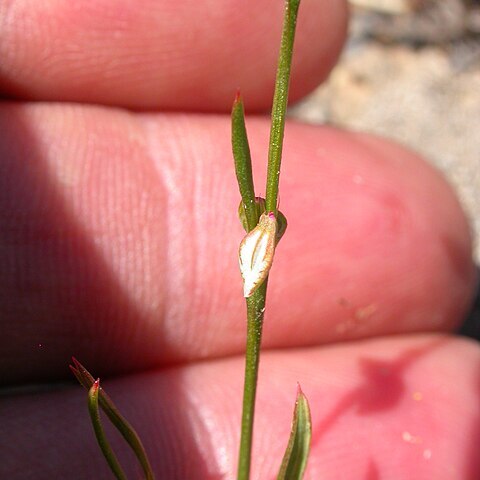Herbs. Stems erect, green, simple or branched, not wiry, 5-80 cm, glabrous or sparsely papillose-scabridulous. Leaves uniformly distributed, articulated to ocreae, basal leaves caducous, distal leaves abruptly reduced to bracts; ocrea 6-12 mm, glabrous or minutely papillose-scabridulous, proximal part cylindric, distal part hyaline, lacerate; petiole 0.1-2 mm; blade 1-veined, not pleated, linear, narrow-oblong, or oblanceolate, 15-55 × 2-8(-12) mm, margins revolute, smooth or papillose-denticulate; apex acute to mucronate. Inflorescences axillary and terminal, spikelike, elongate; cymes widely spaced along branches, 2-4-flowered. Pedicels mostly exserted from ocreae, reflexed, 2-6 mm. Flowers closed; perianth 3-4.5 mm; tube 20-28% of perianth length; tepals overlapping, green to tannish with white or pink margins, petaloid, oblong, cucullate, navicular, apex rounded; midveins usually branched, rarely unbranched; stamens 8. Achenes enclosed in perianth, black, elliptic or oblong to ovate, 3-4(-4.5) mm, faces subequal, shiny or dull, smooth or minutely striate-tubercled.
More
Slender annual, 2–6 dm, with numerous ascending branches; lvs linear-oblong to narrowly lanceolate, 2–5 cm × 2–8 mm, subulate-tipped, flat, often somewhat revolute; fls remote, only 1–3 per ocrea; pedicels 2–3 mm, exsert and soon reflexed; perianth 3–4 mm, cleft nearly to the base; achene black, shiny, 3–4 mm; 2n=40. Open, rocky or gravelly soil; Que. and n. N. Engl. to ne. Minn. and Io.; widespread in w. U.S.
A slender annual herb. It grows 10-40 cm tall. The lower leaves are oval. There are sword shaped bracts up the stem. The fruit point downward.
Dry, often disturbed places, rock outcrops, sandy ground; at elevations from 300-3,000 metres.
More
It is a temperate plant. It grows in dry slopes in prairies and sub alpine zones in Canada.

